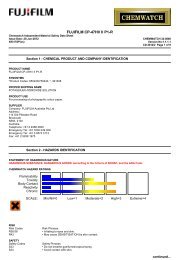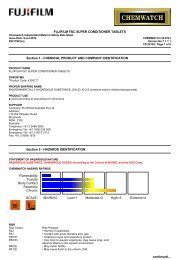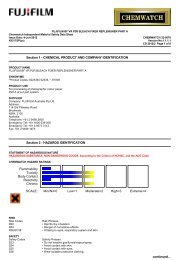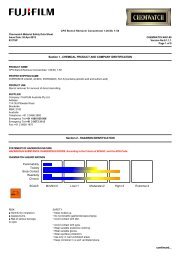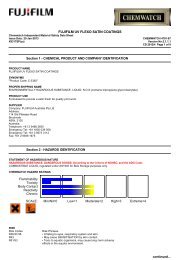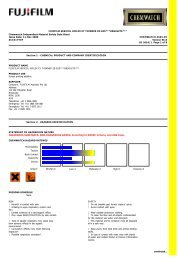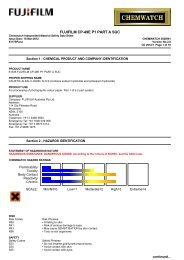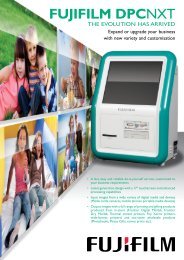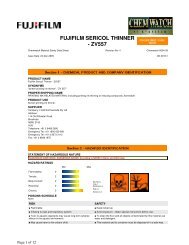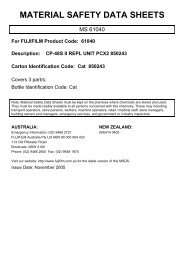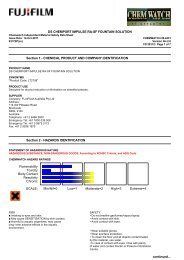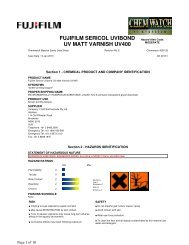CPS Haze Remover HV - FUJIFILM Australia
CPS Haze Remover HV - FUJIFILM Australia
CPS Haze Remover HV - FUJIFILM Australia
Create successful ePaper yourself
Turn your PDF publications into a flip-book with our unique Google optimized e-Paper software.
<strong>CPS</strong> HAZE REMOVER <strong>HV</strong>Chemwatch Independent Material Safety Data SheetIssue Date: 25-Jul-2013 CHEMWATCH 4861-179317SP(cs)Version No:2.1.1.1CD 2013/2 Page 3 of 9Section 4 - FIRST AID MEASURES• Emesis or lavage and catharsis may be indicated for mild caustic exposure.Excellent warning properties force rapid escape of personnel from chlorine vapour thus most inhalations are mild to moderate. Ifescape is not possible, exposure to high concentrations for a very short time can result in dyspnea, haemophysis and cyanosiswith later complications being tracheobroncho-pneumonitis and pulmonary oedema.Depending on the degree of exposure, periodic medical examination is indicated. The symptoms of lung oedema often do not manifestuntil a few hours have passed and they are aggravated by physical effort.Section 5 - FIRE FIGHTING MEASURESEXTINGUISHING MEDIA• Water spray or fog.• Foam.• Dry chemical powder.• BCF (where regulations permit).FIRE FIGHTING• Alert Fire Brigade and tell them location and nature of hazard.• Wear full body protective clothing with breathing apparatus.• Prevent, by any means available, spillage from entering drains or water course.• Use fire fighting procedures suitable for surrounding area.FIRE/EXPLOSION HAZARD• Non combustible.• Not considered to be a significant fire risk.• Expansion or decomposition on heating may lead to violent rupture of containers.• Decomposes on heating and may produce toxic fumes of carbon monoxide (CO).Decomposes on heating and produces toxic fumes of: hydrogen chloride.FIRE INCOMPATIBILITY■ None known.HAZCHEM2XSection 6 - ACCIDENTAL RELEASE MEASURESMINOR SPILLS• Drains for storage or use areas should have retention basins for pH adjustments and dilution of spills before discharge ordisposal of material.• Check regularly for spills and leaks.• Clean up all spills immediately.• Avoid breathing vapours and contact with skin and eyes.• Control personal contact with the substance, by using protective equipment.• Contain and absorb spill with sand, earth, inert material or vermiculite.MAJOR SPILLS• Clear area of personnel and move upwind.• Alert Fire Brigade and tell them location and nature of hazard.• Wear full body protective clothing with breathing apparatus.• Prevent, by any means available, spillage from entering drains or water course.Personal Protective Equipment advice is contained in Section 8 of the MSDS.Section 7 - HANDLING AND STORAGEPROCEDURE FOR HANDLING• DO NOT allow clothing wet with material to stay in contact with skin.• Avoid all personal contact, including inhalation.• Wear protective clothing when risk of exposure occurs.• Use in a well-ventilated area.• WARNING: To avoid violent reaction, ALWAYS add material to water and NEVER water to material.continued...



